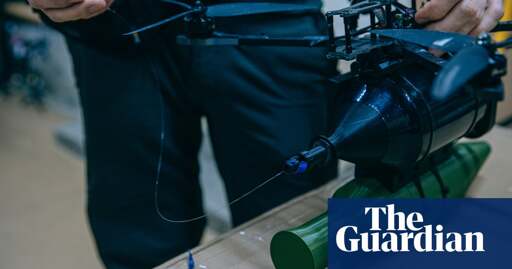At a secret workshop in Ukraine’s north-east, where about 20 people assemble hundreds of FPV (first person view) drones, there is a new design. Under the frame of the familiar quadcopter is a cylinder, the size of a forearm. Coiled up inside is fibre optic cable, 10km (6 miles) or even 20km long, to create a wired kamikaze drone.
Capt Yuriy Fedorenko, the commander of a specialist drone unit, the Achilles regiment, says fibre optic drones were an experimental response to battlefield jamming and rapidly took off late last year. With no radio connection, they cannot be jammed, are difficult to detect and able to fly in ways conventional FPV drones cannot.
“If pilots are experienced, they can fly these drones very low and between the trees in a forest or tree line. If you are flying with a regular drone, the trees block the signal unless you have a re-transmitter close,” he observes. Where tree lined supply roads were thought safer, fibre optic drones have been able to get through.
Another proof that wired connections are superior
Rhythm and fighting game players have known this for decades now
Yes we fucking do
I N P U T L A G
Damn straight.
Wouldn’t the fiber lead directly back to the pilot, though? You’d have to constantly be moving locations, otherwise they could just follow the wire.
Edit: I know, I know, the more I’ve thought about it–and despite them actually proving it’s possible to do as mentioned in the article–it’s just not very practical to do in many situations. As one commenter mentioned below, after seeing pictures of some trees, numerous drones create a web among trees/bushes/etc. So tracing lines when drones are launched from multiple locations would be extremely difficult and they could even set up ambushed at certain points if they saw enemy scouts doing it.
It’s real long, like miles of fairly small transparent cable.
From the article :
There are examples of drone operators from earlier this year being able to trace the cables back to the positions from where they were launched and target the enemy crews. But if this technique was a successful one, fibre optic drones would have disappeared as soon as they appeared on the battlefield, when – from presidents to workshops – all the talk is of increasing numbers.
You won’t be able to just follow the wire, it’s millimeter thin and extremely light. And drone operators need to constantly move anyway.
It’ll be hard to spot but easy to follow. But the drone and the wire don’t need to go in a straight line. Anything could be waiting on the route between the operator and the drone.
I don’t know about “easy to follow.” Have you ever followed 6 miles of transparent fishing line through an active warzone to see what was at the other end? That seems to approximate the difficulty.
Oh oh oh! I’ve actually done this! I was a TOW gunner that had to try and find 3000 meters of wire from a training range after I was done shooting. It fucking sucked and took hours lmao ain’t no fucking way you’re doing that AND getting shot at.
And drone operators need to constantly move anyway.
It’s probably not required if not using RF.
This is not new tech. We have been using wires like this in the battlefield since the 70’s. I was a TOW gunner and shot plenty of missiles that have a wire like this drone. Except, ya know it’s a missile and it moves significantly faster. TOW stands for Tube launched Opitically Wire guided missile.
Ask away if you wanna know anything about em.
Would you rather have had wire drones over your TOWs?
Or just knee replacements
Already had the back replacement thank you very much lol
Edit: sorry to answer your question. Nope, ill take the missile. A drone coming at you is slow (in relation to a missile) and doesnt have a lot of explosives, other enemies will think they have a chance. You see a missile take someone out, I promise you, that you wont stick around to see it again.
Is that where the phrase “pink mist” comes from?
Yeah I probably wouldn’t stick around either.
Lol naw TOW missile just looks like a gray puff when it blows up. Not as exciting unless the thing you’re hitting is full of fuel and ammo. Then the boom is what you think it would look like (fire ball and all that).
Pink mist is for snipers. You’re so zoomed in from the scope you can actually see the splat and it looks like a pink mist. You can also achieve the same effect with large caliber weapons like a 25mm cannon. Interestingly enough, the Barrett .50 cal sniper that everyone knows is classified as a SASR, Special Application Scoped Rifle. Its not meant for people, its an “anti-material” weapon. You’re only supposed to use it to shoot out engine blocks.
Well, since we’ve got you:
What would be the minimum reasonable distance to use a TOW (with accompanying operator control) vs something unguided (either the TOW or otherwise)?
Ooo minimum? Dont recall that exactly but I do remember the mechanism that arms the missile is activated by G force. Missile has to fly for a bit before it arms.
Second part of your question is pretty loaded. Theres tons of unguided systems that have wildly different arming mechanisms.
Really what you care about is stand off distance. Can I hit my enemy with my missile before they can get into range to shoot me?
I’m guessing the wired break down quickly?
Naw, that shit was super strong. If you caught your boot and pulled it would slice clean into your boot. But it was fragile enough to be cut with scissors. A little thicker than a strand of hair.
Lol, I doubt it. I’m guessing 1,000-2,000 years.
What kind of comms do the wires allow? Sending guidance and simultaneously receiving video?
What was the physicality of wires back then (and do you know what they are today)? Would it feel like walking into a spider’s web, or how sturdy were/are those wires?
How often would a write break, and would that mean total loss of control or is there some form of fall-back?
Curious minds want to know! Thank you.
People who play War Thunder want to know lol you can actually find cut outs that show the internals online. The TOW has been around for awhile.
But the wires were for X and Y navigation. Theres an IR beacon that flashes out the back of the missile. The camera sees the beacon and when you move the controls the missile will follow. Theres a Russian T90 tank that has a defense system that spoofs the beacon. Looks like headlights, called the Shtora-1 check it out.
Wire was made out of the thinnest, strongest metal I’ve ever seen. It would cut your boot if you snagged it and pulled, but it could be cut with scissors.
If you lost a wire the missile would go erratic and would lose control depending on which wire was lost. Really depened on what youre trying to shoot over if you broke a wire. Can’t shoot over buildings.
My favorite fact though, it flys above the tank! Search YouTube for a slow mo and you’ll see what i mean. Explodes from above.
Today’s wires aren’t actually wires, they are optical fibers. It must be G.652 or G.657 from telecom use, since that’s commercially available en masse. I think most likely would be G.657.A2 because that can be bent tighter. Here’s an example data sheet from a random google search. I wrote it in a different comment already, but the core has 9 micrometer, the cladding 125 micrometer and the coating 250 micrometer diameter. For telecom applications you’d add at least a mantle, or more likely use a cable with many fibers in little pastic tubes wrapped around a metal core for stability, 12 x 12 is fairly standard. Here of course it’s just a single fiber without mantle being spooled off.
What kind of comms do the wires allow?
In case of FPV drones, anything up to and including gigabit TCP/IP.
Bidirectional transceivers (so both directions on a single fiber) can do 100 Gbit/s ethernet too. No way you’d do that for drones of course, but just to show how far you can get with a single fiber.
And for unidirectional we’re rapidly approaching 1.2Tb at the top end. 400Gb and 800Gb are becoming pretty standard in the datacenter world. Fiber is wild!
Yes, and that’s before muxing!
I need only 75 GHz of spectrum to send 400 Gbit/s through our country. We’ve currently got a link running between Zürich and Lugano (two amplifier sites in between, before and after the alps), and I’ve got 4400 GHz of usable spectrum with our currently deployed system, so if we needed it and spent like two million dollars we could deploy 23.2 Tbit/s within months, using just our normal commercial stuff, on a single fiber pair.
Coolest thing you ever shot with a TOW? Man/building/vehicle etc
How many TOWs did you shoot over your career? What percentage missed intended target?
What’s the kill zone radius of the blast?
Thanks for your service mate.
Hurting people is wrong and should be avoided at all costs. Nothing cool about that.
But when a tank is also full of fuel and ammo, the boom is much bigger lol
I got lucky and shot around 15 to 20 for training. I lost track after 10. Some missilemen never get the chance to shoot one.
Interestingly, I had that kill zone question asked to me by another higher up (different job) and it took me a long time to come to a conclusion. The kill radius is actually not defined in the manuals. There are zones for the shooter to ensure you don’t get hit with back blast, but usually it’s assumed that the vehicle you hit will be destroyed.
Edit:
To explain further, the missile doesn’t hit the target. It flys above it and uses the munroe effect to cause an implosion (not an explosion) that makes the vehicle explode from the inside out. First munroe charge punches a hole into the vehicle, second charge gets sucked in and blow it up from inside. YouTube munroe effect to see how that shape charge works.
Aside from the silly ‘don’t hurt people’, thanks for the answers.
If they’re up to 20 km it could take you a while and they’re very small and difficult to see, possibly going through difficult terrain.
Plus, by the time you find the end, the crew can have moved on.
You could also exploit that to ambush the people trying to follow the cable farther into enemy territory.
Also, assuming the Ops are closer than the max length of the cable, you can fly it in circles or backtracks to make tracing it that much harder.
Perhaps they just pull it back real fast 😆
I was thinking the same thing! If it’s a super small cable (1mm diameter) couldn’t they have some sort of auto winch that pulled the line back after detonation? I’m not an engineer, so I’d obviously defer to an expert on this.
Primary issues I can see with retrieval are tangling/kinking and re-spooling/splicing. The fibers are insanely thin and the drones are flying in between trees, not exactly a smooth path for retrieval.
I saw a picture a few weeks ago of a field in Ukraine, taken from amongst an adjacent patch of trees, and it just looks like spiderwebs. Dozens and dozens of fine spider web strands, each one delivering a drone into the meat grinder. Terrible, beautiful, and such a fucking waste.
What are all those glass fibers going to do to an area after the war ends? That stuff won’t decompose.
Same can be said for the landmines that the Russian are hiding in Ukrainian soil
Fibre glass is essentially silica fibres with a trace amount of metal to make the fibre glass act the way it does. Guess what sand is also made of, silica with trace amounts of impurities. So when they break down it’ll just be sand in the end. Not ‘decomposable’ but quite friendly to the environment still.
Yes, that is obvious. I’m not worried about chemical contamination. Physical contamination and injury is the problem. I’m much more worried about civilians interacting with an environment saturated with these things. A kid is riding a dirt bike through the woods one day and gets garroted on an invisible glass wire dangling between two trees.
I doubt the wire would be strong enough to not snap in that case.
To be fair it’s much better than unexploded bombs and mines.
A kid is riding a dirt bike through the woods one day and gets garroted on an invisible glass wire dangling between two trees
In an interesting tangent, that’s actually a thing in brazil. If I remember, there are laws in place that make it illegal to operate a motorcycle without a wire cutter on it.
Ahh I wasn’t really thinking of the injury implications. In terms of after war cleanup and decades on effects to civilians I didn’t think it was a problem. At least clean up efforts would be simple enough with just a good pair of gloves and side cutters.
You’ve obviously never embedded a piece of fibre optic cable in your skin. It’s very sharp and will break off inside. It’s not exactly life threatening, but it hurts like a bitch and can be really hard to find and remove.
I’ve stabbed myself with fibre optic and I do agree, it’s not nice, a lot better than unexploded ordanance though so I didn’t think of the injury implications.
I live in an area where fires are frequent and aerial cables plentiful.
Once in a while, a crew comes around and picks up all the broken cable. But considering these are mostly glass, non insulated cables, I’d risk it just becomes another inert part of the soil.
Hopefully, there will be a retrieval plan, after all the madness ends.
It’s also not going to explode so probably less of an issue on the whole than all the UXO there…
- wire spool is located on the drone itself not the other way around
- You can’t pull it back it’s all tangled up
- Wires are very hard to see
Not just that but the pilot can be on the other side of the world from wherever the fiber leads out.
Most likely the fiber is coming out of a bunker that just has some switches and a TACLANE or something similar. Doesn’t take much infra…you need that, some sort of low-latency network connection, and room for drones to take off.
Once it’s set up, the site can be unmanned. Hell they can rig it to blow itself up after the mission is complete, so that nothing can be recovered from the infra if it’s found.
For that matter, most of the drones flight path could be pre- programmed…the pilot only there as a contingency. Doing that, one operator could control several drones simultaneously.
Could have controller-> radio -> base station-> fibre —> drone
RR transmitters can be passively triangulated. Following the wire requires someone physically following the line back.
There are a lot of counter options and I’m sure they’ve thought of many. I can think of a couple with a few minutes of thought and it’s not my life on the line.
If the line can be reeled out it can be reeled in.
They could use a smaller drone to send the end randomly elsewhere.
They could have the drone itself detach from the source and reel it towards itself before detonating.
Couldn’t they just make it standard practice to reel in the wire after detonation? Sure, it could snap, but that would still be only partial direction information.
I assume there are ways of doible backing in some unexpected direction first before flying out of one thicket into another and maybe then to the enemy? I am just guessing what is practical though
Sure, but not as quickly as you could triangulate artillery and they already have shoot and move tactics to avoid retaliation for that.
This kind of idea is between genius and stupid.
It’s a cheap an easy solution to a lot of problem, and it sounds like the kind of proposal an intern would do
Drone manufacturer: “We’re having trouble with our drones getting jammed, any ideas?”
Intern: “I always use CAT6 for my pc”
Drone manufacturer: “You goddamn genius!”
Kids these days relying on wireless everything and don’t realize the security and reliability of a wired connection.
It’s neither, they’re spare wire reels for older tow missiles which were wired for the same reason.
TIL thanks,
I heard about wired torpedo but didn’t know it was also a thing for missiles
Yep, still used in combat too and chances are you’ve seen a video and just didn’t know.
Anytime you see a video filmed from behind a missile and it keeps making smingly random swirling jinking movements it’s likely to be a tow missile.
Curiously, the first wired torpedoes, you’d propel the torpedo forward by pulling on the wire that came out the back of it.
It’s neither, they’re spare wire reels for older tow missiles which were wired for the same reason.
Nope, it’s all telecom fiber. TOW uses copper to my knowledge (never seen one, not fully certain). Droners use telecom grade single mode fiber (fused silica, 125 micrometer diameter, acrylic coated).
https://www.thinkdefence.co.uk/2023/05/fibre-optic-guided-missiles-efog-m-polyphem-and-others/
Depends on the missile but in this case we know they’ve said they got the idea from old tow missile reels because the folks who built them made mention of it.
Its not copper either. The meth heads outside the military bases knew to leave TOW wire as recycling places wont take it. I was a TOW gunner and had to reel in miles of that shit when we finished a training range.
Its absolutely a metal of some sort, but it’s super strong. If it wrapped around your boot and you yanked to it to get it off, it would cut straight through your boot. Insanely strong but you could still snip it with scissors. Wild shit.
Sure, but a 20km attack radius in terms of something that can fly seems… Idk less than effective.
It would work for precision bombing nearby targets, but for long range strikes like Ukraine does, they need to be untethered.
But in those cases, i doubt they run remotely, rather they set a GPS destination and they use a combination of astral navigation and inertial navigation to hit their intended target, just like missiles.
Just much slower, smaller and lower flying missiles. Can’t shoot what you can’t see on radar.
They are generally tactical weapons, not strategic.
And here my civvy ass is goin “wait they’re different?”
When talking about attack drones, historically that has described an unmanned bomber that has significant range and strike capability. These are a strategic asset, operated far back from the front and making big-picture attacks. They replace cruise missiles and manned bombers.
The war in Ukraine has led to the first major deployment of tactical drones. These are relatively short range and operated in the field. Some are simply hobby drones rigged up to be able to drop a grenade, while others are flown straight into a target and explode. This article is talking about the latter, which is basically a replacement for anti-tank missiles.
When compared against a missile you have to have line of sight to guide to the target, a 20km range is a huge step up.
Oh. Dang yo, I didn’t even think about out of sight anti-tanl. That’s a huge step up. You’re no longer looking down the barrel of a 130mm(idk) gun hoping your missile hits before they fire
Any FPV or modified commercial drone are not doing long range strikes. They are used previously as you suggested, bombing nearby targets. Assisting troops, stopping vehicle assaults and hitting mortar positions etc.
Long range drones are essentially an unmanned remotely controlled plane, like a Predator.
These wired systems are on small FPV and commercial drones which without the use of repeaters etc aren’t capable of 20km to begin with.
A 150-200mm drone frame wouldn’t have that kind of range in its battery, anyway. There are useful drones in the war that are even smaller than that.
Ok so I have an 85mm micro whoop. Or had i probably should toss the batteries. Those batteries last 3 minutes tops, so you’d be limited to maybe a round trip of 3km, 5km if you let it die where you send it.
That’s not carrying anything, that’s just remote surveillance. I get how that can be insanely useful on the battlefield, but if you attach a 20km fiber optic cable (without adding in friction of the cable and air resistance) on an 85mm it’s going a fat lot of nowhere. It’s about 125g per meter of fiber optic.
Unless the drones you’re talking are tiny ultralight plane things with some incredible battery, I don’t see any tiny drone with that kind of range.
Unless! Unless, and I don’t find it very likely, but there’s some other power delivery going on I don’t know about.
This has been going on for a few months now. Why is this a “new threat” ?
There have even already been battlefield videos where you see tons of fibre optic in the air.
On the scale of human warfare, “a few months” is pretty new. Frankly, its fairly new on the timescale of the Ukraine war at this point.
What does that look like? Can’t imagine what tons of fiber in the air looks like, do you have a video you can share with the rest of the class
Imagine walking into a spider’s web, and you couldn’t just wipe it off your face.
It’s a minor concern when a nation’s existence is on the line, but I do wonder how all those wires will affect the fauna and environment.
I do wonder how all those wires will affect the fauna and environment.
I have actually no idea what the effects would be here. But when this land gets reclaimed by Ukraine they’ll need to clean it up regardless. There’s mines and other explosives, burned out cars, and even dead bodies to clear.
A few months? Closer to a year.
Damn time flies.
Maybe I’m thinking about how long Ukraine has been doing it?
deleted by creator
Next evolution, carrier drones. Larger fiber drones that carry smaller radio drones and can also act as a repeater when needed.
“Carrier has arrived.”
This is getting scary lol
That was actually where my mind went first too. The big issue with current drones is signal strength and jammers. But if you’re able to just plop a wired signal repeater anywhere you can get a drone, then that solves a lot of the issues with signal strength. The article even mentions that these fiber drones are being used for forested deployments, where trees would normally block signals. But what if you just use the fiber drone as a repeater? Now you can send out your wireless drones without any of the issues of carrying a wire.
Already exist.
Those news are already not so new any more. We’ve had reports of those two months ago.
Since fiber optic wire guided missiles exist it’s not that much of a leap to think it should work with drones too, so long as the weight works out.
Fiber is really really thin. 9 micrometer core diameter and 125 micrometer cladding diameter (incl core) and 250 micrometer coating diameter (incl core, cladding). The 10 km spools we use in our lab for network equipment testing are boxes of only like 20x20x10cm, and those aren’t optimized to be extra small with bend insensitive fiber. I can totally believe the 1.2-1.4 kg for 10 km in the article.
Edit: leak -> leap
Wire guided missiles have been in use since WWII.
Markus Reisner has a pretty good explanation of how they’re deployed in one of his videos.
They have much shorter range so they basically set them up as ambushes. The wired drone gets hidden somewhere at a choke point. An other operator flies a recon drone at long range. When they report that a good target has come into range the wired drone takes off and hits the target.
The only news here are the ukrainians using them. Russia has had them for years by this point.
So basically we need a REALLY big wall
Multiphasic drones capable of passing through solid material are next!
Ghost drones?
We need a militarized Pac Man drone.
this sounds so stupid but it might work
I build some (they aren’t in Ukrainian hands yet, but will be - if they want them, because they’re advancing super fast and could be many steps ahead). There is no “might”, they work.
10 kilometers of fiber weighs 1.5 kg, less if you buy fancier kinds of fiber. A drone with 10-inch props lifts this without problems. You can bend the fiber around a pencil and only experience degraded signal. Only a 90-degree bend will make it snap. In the war zone, landscapes after some battles already resemble “attack of the spiders” movies.
In peace time, the challenge is finding a farmer who allows using their field to test this. Promising to reel everything in and pay for damaged crops goes a long way, though. But sea is an even better idea - easier to reel it back.
P.S.
I am quite grateful to an Ukrainian radio amateur, Serhii “Flash” Beskrestnov. He published info about the early Russian models that were found crashed, and made a big deal about it, as one should. People listened to him and took him seriously, and started developing them ASAP.
bend the fiber around a pencil and only experience degraded signal
Interesting. Are you using G.657.A2 then?
According to labels, I’m using plain ordinary G.652.D with a 25 mm bending radius. Maybe I got lucky with the pencil experiment. :)
I know the “bend insensitive” versions exist, but when the cheaper alternative worked, there seemed to be no need.
Wow interesting! Thanks for checking the label!
At first I imagined the drone dragging its cable and that seemed terrible, but then I realized they’re carrying a spool and they let cable out as they go. That’s actually brilliant and absolutely could work. 12 miles of cable. Only thing is it adds weight so you can’t deliver as much explosive payload.
Honestly, it’s old tech. There were guide-by-wire missiles for a long time before this.
I mean, yeah, so is electricity, aerofoils, and explosives. Old tech.
I’m not sure what your point is…
It’s easier, and doesn’t look this bad for you, if you simply don’t say anything when you have no idea what is going on.
Ah yes, an internet classic.
Instead of engaging in meaningful conversation when the topic gets tough, you would prefer to fall back to insults.
👏
There’s is no meaningful conversation here. You simply have no idea what you’re talking about. So yes i will call you out on that. Use as many emojis as youd like, it doesn’t change anything.
Like torpedos used to do.
Stupid like a TOW missle.
They do work. They’ve been using them to blow up tanks.
Sure. But it just might still work.
Reminds me of those old torpedos where the propeller was powered by pulling a cable.
There were some actual torpedoes that used miles-long wire to control
I think they still do.
deleted by creator
Huh, I remember one of the few draw backs of fiber optic cables being that you had to be very careful with them, because bending them could easily cause them to crack and no longer work. I’m guessing that must no longer be an issue!
The fiber we use at our datacenter is quite flexible but still gets damaged if you bend it too far. To roll it like they describe you would still want to have a fairly large drum (probably like 3-4 inches in diameter) which would make it pretty bulky for a small drone.
They literally describe it as “the size of a forearm” so that about tracks with 3-4 inches diameter.

Using G.657.A2 fiber you could get away with 7.5 mm bend radius, or 15 mm diameter, for the innermost layer of the spool. That’s around 5/8 inch for freedom units.
But then again if you went that tight you’d need like 56’000 windings for 10 km. That sounds like a fuckton, and like we can’t ignore the outer diameter being larger.
Approaching it from the other side: The fiber diameter with coating but without any mantle is 0.25 mm. If you want to put 10 km on a 100 mm long spool you could put in 400 layers lengthwise, and each layer would have to be a spiral of 25 m (of course you’d spool it outside in, not layer by layer, but should be mathematically similar enough). Using this spiral calculator and some random changing of the values it looks like an outer diameter of 91 mm (3 & 5/8 inch), and inner of 15 mm and a thinkness of 0.25 mm would work for a 25 m spiral.
Or if we go for 125 mm drum length, so 500 layers, with 20 m each we get 82 mm (3 & 1/4 inch) outer diameter.
Or if we go for 150 mm drum length, so 600 layers, with 16.7 m each we get 75 mm (3 inch) outer diameter.
So yeah I think your estimate was pretty spot on, if the 10 km length is the right assumption.
Perhaps a sonic weapon at the right frequency could crack the wires?
“Secret workshop”? Why are they talking openly to the press then?
Because the secret is where it is, not that it exists.
Why talk about it at all though? What military benefits from telling the press about its newest weapons?
The tech itself isn’t secret, both sides use it. With Russia being ahead apparently. From the article:
A video from a Russian military Telegram channel from last month demonstrates their ominous capability. A fibre optic drone, the nose of the yellow cylinder housing the coil clearly visible, flies with precision a few centimetres from the ground, to strike a Ukrainian howitzer concealed in a barn, a location clearly previously considered safe.
But as Fedorenko acknowledges, it is Russia that, at least for now, “is well ahead of us” – largely because Moscow has had greater access to fibre optic cabling, with Ukraine scrambling to catch up.
Y’all answering “what” to a “why” question.
It’s news about how the current battlefield works. Recently Ukraine even explained how they were finding and ambushing Russian drone operators. As soon as Russia is aware of the tactics and methods, it’s not a secret anymore and it can be shared. There’s tons of reporters that are always looking around for news about the war.
Mankind invents their own problems… fantastic… 🙄
Don’t these reveal the location of the operator, though?
How? If you think they’re going to successfully follow a filament thinner than human hair over 6 miles I’d love to know
Ok, but then how strong can such a filament be? Seems like anything and everything could potentially severe the connection
there’s literally 70 years of fly by wire minitions I’m sure there’s a rich back and forth series of countermeasures and baffles
Since the filament is not under tension as it is unwinding I think unless someone intentionally cuts it or it jams somehow it should not jus break.
I mean after the attack the strands left could be used to trace operation spots. But I guess you’re right, I didn’t realise they were that thin
You may be right, but not quickly and either end can cut and run of they find the line intercepted. These usually aren’t launched from a stationary base
Drop off this drone with a different drone. Then fly it out wherever the other drones couldn’t get to.
It’s a flying nightmare, until somebody figures out how to cut the cable in flight.
Got to catch the thing first. I’m sure they are using fancier shit but I have an Avata2 that can hit about 50mph and is wildly maneuverable. I would be interested to the the specs on one of those. You would also need a pilot skilled enough to fly it. I think we’ll start some type of micro-missile drone killer weapons in the near future.
What I’m imagining is more like a flying knife.
flying knife missiles
With lasers! Shooting through the fiber optic cable, but still. LASERS!
The way they’re used there isn’t much time for that. With regular drones they hunt around for something to kill and then dive in. The wired drones stay hidden until the target comes into range and then they just come out for the strike. The defenders only have a few seconds to react.
Knowing how fragile fibre cable is especially when bent at weird angles (which is prone to happen in flight), this doesn’t sound like the most genius idea. I guess we’ll have to wait and see.
There are some turning radius limitations but otherwise these drones are doing just fine from both sides. We don’t have to wait and see anything.
Madyar has been running these for a while and it looks like Code 9.2 Achilles also.
Fibre cable is a lot stronger and more flexible than you’d think. The old days of very fragile cable are gone. You can use it and treat it in pretty much the same way you’d treat copper CAT6 cable in terms of bend radius.
Yeah I’ve purposely broken some fiber just to learn what kind of stress it can handle. I had to literally fold it over on itself to snap it
deleted by creator
It has been in use for a few months already and has proven to be very reliant. Force upon the cable seems to unroll the spool before breaking the cable.
And there’s even more fun stuff. Ukrainian drones are currently playing around with visual target locking in case of signal loss. It works very well for tank mounted scramblers.
That’s actually cool to know. Thanks for the info
If it was that bad, they wouldn’t be using it. Consider that the same is true for regular munitions. They’re meant to be disposable, so if they have a few duds, it’s probably not the end of the world.
Its not brand new stuff. It works, no need to wait and see at all.

















